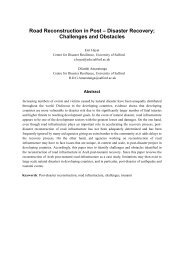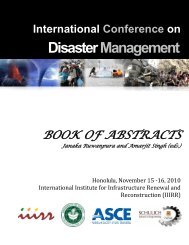Alternative resilient livelihood option for fisher-folks tsunami victims
Alternative resilient livelihood option for fisher-folks tsunami victims
Alternative resilient livelihood option for fisher-folks tsunami victims
You also want an ePaper? Increase the reach of your titles
YUMPU automatically turns print PDFs into web optimized ePapers that Google loves.
2.1 Gracilaria farming<br />
Wooden rafts with dimension of 10m X 5m were floated with floats (Figure 1). Coir lines were<br />
stretched between the frames and the lines were supported by another lines running perpendicular to<br />
the main line. Vegetative cuttings of Gracilaria plants were collected from Sinnakalappu (Ampara<br />
District). The average weight of seed stock 20 grams each which is tied to the line at 25cm interval<br />
(Figure 2). Grow-out lines were spaced at intervals varying between 0.2 m. Dirt that clings to the<br />
seaweeds were removed thrice in a week. Once seaweeds are 2 ½ to 3 months old, we started<br />
harvesting them. During the farming time fish in the surrounding area were collected by using fish<br />
traps and were identified to the lowest taxonomic level using FAO species identification field guide<br />
<strong>for</strong> <strong>fisher</strong>y purpose of Sri Lanka by George et al., 1994 and Munro, 1955.<br />
Figure 3: Seaweed raft<br />
Figure 2: Growing in rafts<br />
2.2 Crab fattening<br />
The crab fattening training programmes were executed <strong>for</strong> 20 <strong>fisher</strong> women by our resource<br />
persons. After the training programme, each of them were provided with a crab cage measuring<br />
1.5m x 1.5m x 0.5m (Figure 3) and watery crabs weighing more than 400g. The cages were made<br />
out of wooden frames with Palmyra petiole basement. This type of cage was designed in an<br />
environmentally friendly manner to minimize the physical damages on the crabs and <strong>for</strong> the<br />
reusability of the cages. Crab cages were set up into the shallow water fronts of the Batticaloa<br />
lagoon at different location shown in Figure 5. We have selected only 5 cages <strong>for</strong> our studies out of<br />
20 cages. Each cage was seeded with 10 crablings and trash fish fed at the rate of 10% of the<br />
biomass of the crab at two intervals every day. Sampling of crabs was done on a weekly basis. The<br />
body weight (BW), carapace length (CL) and percentage of survival crabs were calculated from the<br />
total harvest. In our experiment, mean number of crabs surviving and mean number of crabs<br />
declined (mortality) were calculated over time (months) in all the five cages. Weights of crabs at the<br />
time of harvest were measured from this average weight gained was calculated and percentage<br />
weight gain was calculated.

















